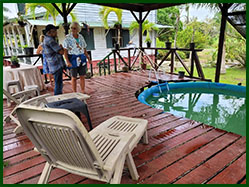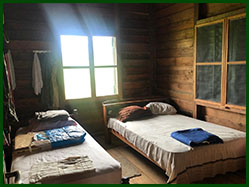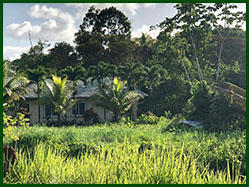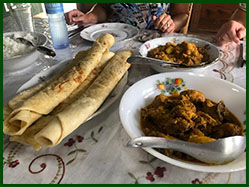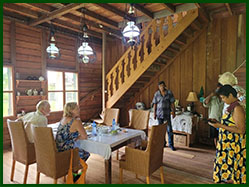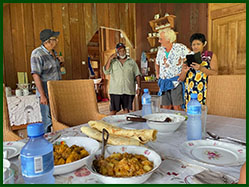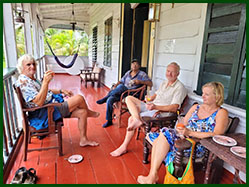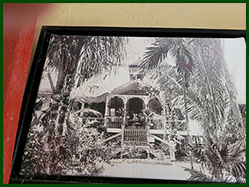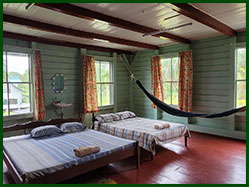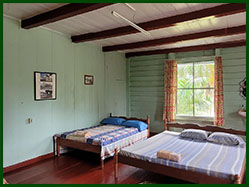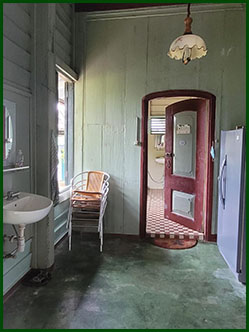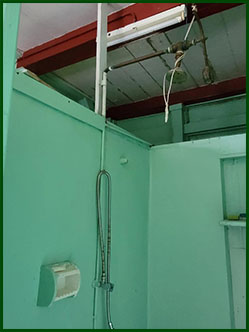Discover the Surinam outback, pristine nature, authentic villages, rapids, wild waterfalls, massaging jacuzzis.
Plantation Mariënbosch
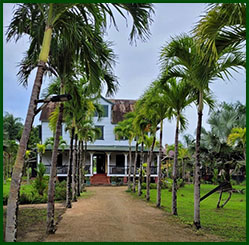
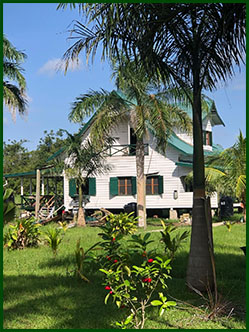 Mariënbosch was a coffee plantation on the Landgoed Groot
Marienbosch, on the Commewijne River in the Commewijne district in
Suriname. She was on the left when sailing upstream, downstream next to plantation Guadeloupe and upstream next to plantation De Goede
Vriendschap. In Sranan Tongo Mariënbosch was also called Gudoefrow.
Mariënbosch was a coffee plantation on the Landgoed Groot
Marienbosch, on the Commewijne River in the Commewijne district in
Suriname. She was on the left when sailing upstream, downstream next to plantation Guadeloupe and upstream next to plantation De Goede
Vriendschap. In Sranan Tongo Mariënbosch was also called Gudoefrow.
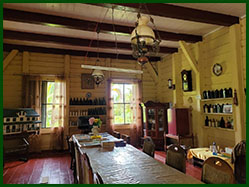 History
History
After the completion of Fort Nieuw-Amsterdam in 1746, the Commewijne River was fully protected and the land at the mouth of the river was reclaimed. In 1747, Isaac Godeffroy obtained a land warrant for 500 acres (1 acre = 10 square chain = 0.43 hectares). Godeffroy called his property Mariënbosch. In 1759 he acquired ownership of the adjacent land of 348 fields and merged it with Mariënbosch, creating a favorable plantation form with a generous width of 51 chains (1 chain = 20.72 metres). In 1752 Mariënbosch was still a relatively modest plantation, with 66 slaves. In 1774 it had grown into a large and wealthy coffee plantation with 170 slaves over the age of 12. At the same time, his brother Charles built the Alkmaar plantation on the other side of the river.
In 1757 the plantation was mortgaged to the negotiation fund of Willem Gideon Deutz in Amsterdam, which was later managed by Jan and Theodoor van Marselis.
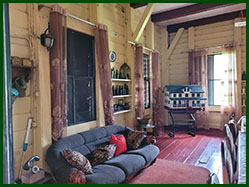 In 1793 the plantation was the property of the Dordrecht merchant Frank
van der Schoor cs. He invested his capital, together with his trading
partner Gerrit van Hoogstraten, in Mariënbosch. He funded the purchase
(partly) through a negotiation. The company Gerrit van Hoogstraten and
son from Dordrecht was probably already co-owner of Mariënbosch from
1780 onwards.
In 1793 the plantation was the property of the Dordrecht merchant Frank
van der Schoor cs. He invested his capital, together with his trading
partner Gerrit van Hoogstraten, in Mariënbosch. He funded the purchase
(partly) through a negotiation. The company Gerrit van Hoogstraten and
son from Dordrecht was probably already co-owner of Mariënbosch from
1780 onwards.
In 1833 Mariënbosch was 1230 fields in size, and the plantation produced coffee & cocoa. The slave population included 142 people. In 1853, Mariënbosch was listed as a coffee plantation “where sugar is now also planted”. That sugar was probably an experiment. Mariënbosch did not have a processing plant of its own, but was able to supply to the Centraalfabriek on Buitenrust. Later on, the sugar was no longer mentioned.
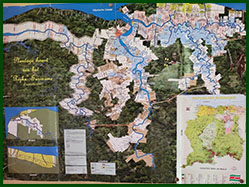 At the emancipation in 1863, 91 slaves were freed. The owners of the
plantation were the Huis van Negocie of Gerrit Hoogstraten and son in
Dordrecht, and the Van der Schoor family in Dordrecht. After
emancipation, the plantation business was continued with contract
workers. A total of 269 Hindustanis and 242 Javanese arrived on the
plantation.
At the emancipation in 1863, 91 slaves were freed. The owners of the
plantation were the Huis van Negocie of Gerrit Hoogstraten and son in
Dordrecht, and the Van der Schoor family in Dordrecht. After
emancipation, the plantation business was continued with contract
workers. A total of 269 Hindustanis and 242 Javanese arrived on the
plantation.
In 1891, of the 527 hectares, 95 hectares were under cultivation. This increased to 196 hectares in 1935. The following year the productive area fell sharply, but the plantation was 200 hectares larger. The plantation produced coffee and cocoa, bananas, rice and oranges. From 1906 to 1938, the plantation was owned by the Naamlooze Samen Cultuur-maatschappij Mariënbosch.
 Cores Abdulrahman and his wife and children are the most recent
owners of the plantation. The property has now been placed in a
foundation, in the hope that it will be easier to raise funds for the
restoration of the plantation. The buildings were quite neglected in 2002,
but the owner at least kept the dams and drainages in good condition. In
2004, the repair of the large plantation house was started on a modest
scale and in 2005 family member Saud completed the renovation of the
old mansion.
Cores Abdulrahman and his wife and children are the most recent
owners of the plantation. The property has now been placed in a
foundation, in the hope that it will be easier to raise funds for the
restoration of the plantation. The buildings were quite neglected in 2002,
but the owner at least kept the dams and drainages in good condition. In
2004, the repair of the large plantation house was started on a modest
scale and in 2005 family member Saud completed the renovation of the
old mansion.
 You can take a rented bicycle from Paramaribo (Zus&Zo bicycle rental
SU) and drive to Leonsberg along the SurinamRiver direction ocean to
take a boat to Fort Nieuw Amsterdam. After visiting the Fort, you can
cycle further upstream along the Commewijne River to Marienburg,
where there is a jetty on the left where the boats will take you to Plantage
Frederiksdorp. Here you can visit the plantation for an entrance fee or
book an overnight stay with me. See the Frederiksdorp bubble. From
here you cycle 1.6 km further upstream to Plantage Marienbosch. Here
you can book a delicious meal for 10 euros and also spend the night in
an authentically restored, simple country house with your own bedroom
and shared bathroom. An overnight stay with breakfast and dinner the
night before costs E 50 p.p. There are also pick-up options on request.
If you make a reservation with me, i can give you a description of the
road. It is also posssible to drive with a rented car of taxi to plantation
Alkmaar and the will pick you up by boat for a lunch and sightseeing! Let
me know! A great lunch costs E 10 p.p.
You can take a rented bicycle from Paramaribo (Zus&Zo bicycle rental
SU) and drive to Leonsberg along the SurinamRiver direction ocean to
take a boat to Fort Nieuw Amsterdam. After visiting the Fort, you can
cycle further upstream along the Commewijne River to Marienburg,
where there is a jetty on the left where the boats will take you to Plantage
Frederiksdorp. Here you can visit the plantation for an entrance fee or
book an overnight stay with me. See the Frederiksdorp bubble. From
here you cycle 1.6 km further upstream to Plantage Marienbosch. Here
you can book a delicious meal for 10 euros and also spend the night in
an authentically restored, simple country house with your own bedroom
and shared bathroom. An overnight stay with breakfast and dinner the
night before costs E 50 p.p. There are also pick-up options on request.
If you make a reservation with me, i can give you a description of the
road. It is also posssible to drive with a rented car of taxi to plantation
Alkmaar and the will pick you up by boat for a lunch and sightseeing! Let
me know! A great lunch costs E 10 p.p.


